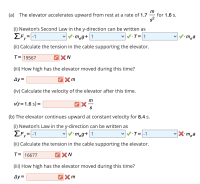
College Physics
11th Edition
ISBN: 9781305952300
Author: Raymond A. Serway, Chris Vuille
Publisher: Cengage Learning
expand_more
expand_more
format_list_bulleted
Concept explainers
Topic Video
Question
An elevator shown below filled with passengers has a mass of 1800 kg. The elevator does motions (a) through (c) in succession.

Transcribed Image Text:(a) The elevator accelerates upward from rest at a rate of 1.7
for 1.6 s.
s2
(i) Newton's Second Law in the y-direction can be written as
T= 1
EF,=-1
meg+ 1
•m¸a
(ii) Calculate the tension in the cable supporting the elevator.
T= 19567
XN
(iii) How high has the elevator moved during this time?
Ay=
(iv) Calculate the velocity of the elevator after this time.
m
v(t=1.6 s) =
%3D
S

Expert Solution
This question has been solved!
Explore an expertly crafted, step-by-step solution for a thorough understanding of key concepts.
This is a popular solution
Trending nowThis is a popular solution!
Step by stepSolved in 2 steps with 4 images

Knowledge Booster
Learn more about
Need a deep-dive on the concept behind this application? Look no further. Learn more about this topic, physics and related others by exploring similar questions and additional content below.Similar questions
- The figure shows a container of mass m₁ = 1.7 kg connected to a block of mass m₂ by a cord looped around a frictionless pulley. The cord and pulley have negligible mass. When the container is released from rest, it accelerates at 1.0 m/s² across the horizontal frictionless surface. What are (a) the tension in the cord and (b) mass m₂? (a) Number (b) Number i Units Units m₁ mq >arrow_forwardA 0.27 kg particle moves in an xy plane according to x(t) = - 11+2 t-6 t³ and y(t) = 17 + 7 t - 9 t², with x and y in meters and t in seconds. At t = 1.0 s, what are (a) the magnitude and (b) the angle (within (-180°, 180°] interval relative to the positive direction of the x axis) of the net force on the particle, and (c) what is the angle of the particle's direction of travel?arrow_forwardQuestion 5: Balls A and B have a mass of 600 g and 1 kg, respectively. If they are sliding on a smooth horizontal plane with the velocities shown, determine their speeds just after impact. The coefficient of restitution between them is e = 0.8. DA= 6 m/s 40° 50° B Ug = 4 m/sarrow_forward
- Two carts, A and B, roll on inclined planes with negligible friction. Cart A has a mass of 1.3 kg and it is on a plane inclined at an angle of ? θ ? θ = 63 degrees. Cart B has a mass of 2.5 kg and it is on a plane inclined at an angle of ? ϕ ? ϕ = 14 degrees. The carts are connected by a (nearly) massless string that runs over a (nearly) massless and frictionless pulley. Find the tension (in newtons) in the string.arrow_forwardYou are in charge of a cannon that exerts a force 17100 N on a cannon ball while the ball is in the barrel of the cannon. The length of the cannon barrel is 2.37 m and the cannon is aimed at a 36.7 ◦ angle from the ground. The acceleration of gravity is 9.8 m/s 2 . If you want the ball to leave the cannon with speed v0 = 89 m/s, what mass cannon ball must you use? Answer in units of kg. Answer in units of kg.arrow_forwardIn the figure here, block 1 of mass 2.2 kg and block 2 of mass 3.4 kg are connected by a string of negligible mass and are initially held in place. Block 2 is on a frictionless surface tilted at 0 = 23 °. The coefficient of kinetic friction between block 1 and the horizontal surface is 0.25. The pulley has negligible mass and friction. Once they are released, the blocks move. What then is the tension in the string? Number i Unitarrow_forward
arrow_back_ios
arrow_forward_ios
Recommended textbooks for you
 College PhysicsPhysicsISBN:9781305952300Author:Raymond A. Serway, Chris VuillePublisher:Cengage Learning
College PhysicsPhysicsISBN:9781305952300Author:Raymond A. Serway, Chris VuillePublisher:Cengage Learning University Physics (14th Edition)PhysicsISBN:9780133969290Author:Hugh D. Young, Roger A. FreedmanPublisher:PEARSON
University Physics (14th Edition)PhysicsISBN:9780133969290Author:Hugh D. Young, Roger A. FreedmanPublisher:PEARSON Introduction To Quantum MechanicsPhysicsISBN:9781107189638Author:Griffiths, David J., Schroeter, Darrell F.Publisher:Cambridge University Press
Introduction To Quantum MechanicsPhysicsISBN:9781107189638Author:Griffiths, David J., Schroeter, Darrell F.Publisher:Cambridge University Press Physics for Scientists and EngineersPhysicsISBN:9781337553278Author:Raymond A. Serway, John W. JewettPublisher:Cengage Learning
Physics for Scientists and EngineersPhysicsISBN:9781337553278Author:Raymond A. Serway, John W. JewettPublisher:Cengage Learning Lecture- Tutorials for Introductory AstronomyPhysicsISBN:9780321820464Author:Edward E. Prather, Tim P. Slater, Jeff P. Adams, Gina BrissendenPublisher:Addison-Wesley
Lecture- Tutorials for Introductory AstronomyPhysicsISBN:9780321820464Author:Edward E. Prather, Tim P. Slater, Jeff P. Adams, Gina BrissendenPublisher:Addison-Wesley College Physics: A Strategic Approach (4th Editio...PhysicsISBN:9780134609034Author:Randall D. Knight (Professor Emeritus), Brian Jones, Stuart FieldPublisher:PEARSON
College Physics: A Strategic Approach (4th Editio...PhysicsISBN:9780134609034Author:Randall D. Knight (Professor Emeritus), Brian Jones, Stuart FieldPublisher:PEARSON

College Physics
Physics
ISBN:9781305952300
Author:Raymond A. Serway, Chris Vuille
Publisher:Cengage Learning

University Physics (14th Edition)
Physics
ISBN:9780133969290
Author:Hugh D. Young, Roger A. Freedman
Publisher:PEARSON

Introduction To Quantum Mechanics
Physics
ISBN:9781107189638
Author:Griffiths, David J., Schroeter, Darrell F.
Publisher:Cambridge University Press

Physics for Scientists and Engineers
Physics
ISBN:9781337553278
Author:Raymond A. Serway, John W. Jewett
Publisher:Cengage Learning

Lecture- Tutorials for Introductory Astronomy
Physics
ISBN:9780321820464
Author:Edward E. Prather, Tim P. Slater, Jeff P. Adams, Gina Brissenden
Publisher:Addison-Wesley

College Physics: A Strategic Approach (4th Editio...
Physics
ISBN:9780134609034
Author:Randall D. Knight (Professor Emeritus), Brian Jones, Stuart Field
Publisher:PEARSON